
|
Astronomy Picture Of the Day (APOD)
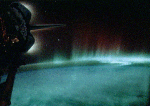 Southern Lights and Shuttle Glow
Southern Lights and Shuttle Glow
6.05.1996
A background of distant stars, sinuous and spiky bands of Southern Lights (Aurora Australis), and the faint glow of charged plasma (ionized atomic gas) surrounding the Space Shuttle Discovery's engines give this photo from the STS-39 mission an eerie, otherworldly look.
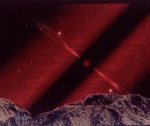 Planet Near a Galaxy Core
Planet Near a Galaxy Core
5.05.1996
What would the night sky look like if you lived on a planet near the center of a galaxy? Now imagine that this galaxy houses a black hole billions of times more massive than a star. From this spectacular vantage point, the sky might look like the above illustration.
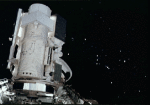 Astro 1 In Orbit
Astro 1 In Orbit
4.05.1996
In December of 1990, the Space Shuttle Columbia carried an array of astronomical telescopes high above the Earth's obscuring atmosphere to observe the Universe at ultraviolet and x-ray wavelengths. The telescopes, known...
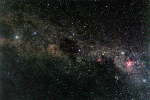 The Milky Way Near the Southern Cross
The Milky Way Near the Southern Cross
3.05.1996
This breathtaking patch of sky would be above you were you to stand at the south pole of the Earth. Just above and to the right of the photograph's center are the four stars that mark the boundaries of the famous Southern Cross.
 The Tails of Comet Hyakutake
The Tails of Comet Hyakutake
2.05.1996
What makes comet tails so colorful? This photograph of Comet Hyakutake was taken the night of April 18th and highlights different components of the tail. The gold and red tail features are dust, made predominately of little bits of rock and carbon. The dust tail shines by reflecting sunlight.
 Comet Hyakutake and a Cactus
Comet Hyakutake and a Cactus
1.05.1996
Comet Hyakutake is shown photographed the night of March 27 in Arizona, USA, with a cactus in the foreground. Polaris, the north star, is the bright star seen just to the upper right of the comet's head. Today Comet Hyakutake reaches its closest approach to the Sun.
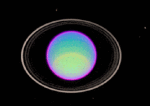 Uranus' Ring System
Uranus' Ring System
30.04.1996
The rings of Uranus are thin, narrow, and dark compared to other planetary ring systems. Brightened artificially by computer, the ring particles reflect as little light as charcoal, although they are really made of ice chucks darkened by rock.
 Saturn's Rings Seen Sideways
Saturn's Rings Seen Sideways
29.04.1996
Saturn's rings are actually very thin. This picture from the Hubble Space Telescope was taken on August 6, 1995 when the rings lined up sideways as seen from Earth. Saturn's largest moon Titan is seen on the left, and Titan's shadow can be seen on Saturn's cloud tops!
 The Sun Sets on Comet Hyakutake
The Sun Sets on Comet Hyakutake
28.04.1996
Comet Hyakutake is seen here just as the Sun sets on April 22. As April draws to a close, Comet Hyakutake will be visible only just after sunset and will be hard to discern against the brightly lit sky.
 Apollo 14: Rickshaw Tracks Across the Moon
Apollo 14: Rickshaw Tracks Across the Moon
27.04.1996
Brilliant sunlight glints off tracks gently winding across the the Moon's Frau Maro highlands. The tracks were made by the Apollo 14 crew's two-wheeled Modularized Equipment Transporter (MET), fondly known as the "rickshaw". The MET was designed as an aid to surface exploration.
|
January February March April |
|||||||||||||||||||||||||||||||||||||||||||||||||